



Editor’s Note: This is paid research from Patrick Cox, provided to you with compliments from John Mauldin. To learn more about our new service, Transformative Age, click here.
By Patrick Cox
In this issue, I’m going to tell you about a novel anti-aging therapy involving hydrogen. It’s becoming increasingly mainstream in Japan and other parts of Asia, to the point that EMTs routinely administer hydrogen gas to patients who have suffered heart attacks. In the process, I’ll give you information that will forever change the way you think about flatulence.
First, however, I want to talk about why emerging anti-aging biotechnologies are uniquely important right now.
Most people know there are things they can do to increase their lifespans and healthspans. Few, however, make any real effort to do those things. Only about one in five Americans engages in regular exercise, and well over half of the population has basic nutrient deficiencies.
In the past, it could have been a rational calculation to enjoy the time you have rather than sacrifice life’s pleasures to gain a few more years of deprivation. Many people are too worn down by the demands of their lives to spend time sorting through a flood of conflicting information about wellness. Economists associated with public choice theory and the Chicago School of Economics have made similar justifications for those who choose not to follow politics or vote.
In the last few years, however, the calculation of how much effort we should put into maximizing our lifespans has fundamentally changed. I’m talking about evidence that we are on the verge of reversing age and dramatically extending healthy lifespans.
The big question, of course, is “when?” Are major breakthroughs going to happen in 10 years or 100? Do we have a shot at being part of the first generation to reverse our biological ages? Or are we doomed to be among the last to live traditional lifespans?
I’m convinced that the major breakthroughs have already happened. We can’t predict when they will be commercialized, however, because biotech is so heavily influenced by factors outside of the science, especially in the regulatory arena.
For that reason, I am focused on identifying biotechnologies that have marginal but important impacts on lifespan. These innovations may allow us to live long enough to benefit from the arrival of the biotech singularity, which will improve healthspans in ways never before seen.
One of these innovations, which I’m covering in this issue, is hydrogen therapy. Already, an approved medical technology in Japan and other parts of Asia, it is supported by solid research demonstrating remarkable therapeutic benefits.
Though Japanese scientists have been at the heart of this story most recently, it started in America. Chicago-born multidisciplinary scientist Malcolm Dole is best known for discovering the “Dole Effect,” which refers to plants’ preference for lighter isotopes of oxygen. In the long run, however, his discoveries regarding hydrogen may be more impactful.
Experimenting with the effects of hydrogen gas on mice in hyperbaric chambers, Dole realized that squamous cell carcinoma, a dangerous form of skin cancer found on the mice, was in regression. He published the results in a 1975 paper in the journal Science titled “Hyperbaric hydrogen therapy: A possible treatment for cancer.” Insightfully, Dole theorized that hydrogen gas “scavenged the most damaging oxidant hydroxyl radical (•OH)” resulting in the reversal of the cancer.
While this may sound like complicated science, the chemistry is simple. The hydroxyl radical consists of one oxygen atom bonded to one hydrogen atom with an unpaired electron.
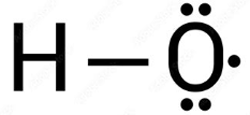
Source: Science
That single dot represents the hydroxyl’s unpaired electron. Metaphorically, it makes the molecule act something like a desperately amorous and inebriated guy at a party. It has no choice but to constantly seek a way to bond with another electron to balance its unpaired charge. When it succeeds, the process is called oxidation, and it poses a particular threat to DNA, causing telomere degradation, strand breaks, altered gene function, and crosslinks that can lead to mutations, genomic instability, cancer, and cell death.
In short, the hydroxyl radical is a major and particularly vicious cause of oxidative stress. Many scientists consider it the most dangerous reactive oxygen species and one of the primary drivers of aging.
There is an exception, however, to the rule that hydroxyl radicals ruin parties. If a hydroxyl radical (•OH) encounters hydrogen, usually in its natural paired state (H2), it instantly takes one of the H2’s hydrogen atoms, forming a new molecule made up of two hydrogens and one oxygen (H20). Water.
In retrospect, it’s unfortunate but understandable that Dole’s research was not continued. The theory that oxidative stress drives aging and disease had been around since the 1950s, but it was not generally accepted until much later. The links between oxidative stress and Alzheimer's disease, for example, were not accepted by the mainstream until the 1990s.
Italian gerontologist Claudio Franceschi and his colleagues coined the term “inflammaging” in 2000 to describe how oxidative stress increases the rate of aging. The following year, 25 years after Dole reversed cancer in mice with hydrogen, French scientists moved the story forward again.
Scientists in Marseille, France tested hydrogen-rich breathing mixtures on mice with liver damage caused by schistosomiasis, a disease caused by a parasitic infection. Two weeks in a hydrogen-enriched environment resulted in reduced liver fibrosis, better antioxidant activity, and general improvements in liver function. Other improved biomarkers included decreased lipid peroxide levels and decreased circulating TNF-alpha levels, both oxidative stressors associated with aging. (For reference, the 2001 paper was published in the journal C R Acad Sci III.)
It is important to understand that hydrogen is the smallest molecule in the universe, so it passes nearly unimpeded through cell walls, bone, and other tissues. When hydrogen is consumed as a free gas or dissolved in water, it can be detected exiting from every location of the body. Along the way, of course, it is neutralizing hydroxyl radicals.
A few years later, scientists at Nippon Medical School used hydrogen gas to treat mice with ischemic stroke. The resultant paper, published in 2007 by Ohsawa et al., is “Hydrogen acts as a therapeutic antioxidant by selectively reducing cytotoxic oxygen radicals.”
To understand the results, we need a basic understanding of the cellular damage caused by a temporary blockage of blood flow (ischemia) of the sort caused by stroke, cardiac arrest, spinal cord compression, and other injuries. You might be surprised to learn that the damage caused by the interruption of blood flow is not primarily caused by the temporary lack of oxygen or nutrients. To a significant extent, cells can recover from those transient reductions in blood flow.
Rather, most of the cellular damage occurs when blood flow is restored during the process known as reperfusion. This is known as ischemia/reperfusion (IR) injury and much has been written about it. I’ll link to one paper if you feel like learning more about it. It is “Ischemia-reperfusion injury pathophysiology, part I, 2004.”
The authors of that article explain that the body has numerous mechanisms for dealing with free radicals created during normal blood flow. In fact, some free radicals play beneficial signaling roles. During ischemia, however, there is a buildup of molecules that generate free radicals in the presence of oxygen, including the dangerous hydroxyl radicals. When blood and oxygen are restored, normal protective mechanisms are overwhelmed, leading to cell damage.
Ohsawa et al. pointed out in their 2007 paper, “Hydrogen acts as a therapeutic antioxidant by selectively reducing cytotoxic oxygen radicals,” that there was no effective system for detoxifying high levels of hydroxyl radicals created during blood flow restoration. They also showed, however, that hydrogen does just that. Moreover, it does so in a very selective manner that spares beneficial oxidants like nitric oxide, the gas responsible for vasodilation, which increases blood flow.
The word “reducing” in the title of that paper, by the way, refers to the chemical process of gaining electrons, or reduction. It is the opposite of oxidation, which is losing electrons. Together, they make up the “redox” reaction.
The following graphic from that paper shows that cell death in animals given hydrogen gas during reperfusion, shown in the dark bars, was significantly lower than the control group. Moreover, that trend accelerated for 100 hours, more than four days. Further analysis showed that the differences in cell death between the hydrogen and control continued to increase for a week.
The paper states, “Moreover, although body weight and body temperature of H2-untreated rats gradually declined, those in H2-treated rats eventually recovered. Thus H2 suppressed not only the initial brain injury, but also its progressive damage.”
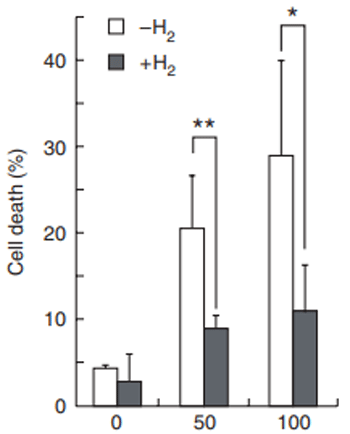
Source: Nature Medicine
Predictably, these results provoked further investigation into hydrogen therapy, mostly in animals and cells. Confirmation that H2 neutralized hydroxyls and other reactive oxygen species were found in numerous studies, “Hydrogen protects lung from hypoxia/re-oxygenation injury by reducing hydroxyl radical production and inhibiting inflammatory responses.” Nature Scientific Reports, 2018. It showed that hydrogen decreased the production of hydroxyl radicals caused by severe oxygen deprivation and re-oxygenation in mice.
A study in Nature Scientific Reports, 2016, “Hydrogen prevents corneal endothelial damage in phacoemulsification cataract surgery,” showed that hydrogen gas dissolved in an irrigating solution reduced hydroxyl radical (•OH) formation during phacoemulsification cataract surgery. The test subjects were rabbits, which are recognized as a good substitute for human eyes in clinical trials.
Hydrogen was even shown to protect hematopoietic stem cells (HSC) in mice from the harmful effects of total body irradiation. HSCs, found in bone marrow, are one of the most critical types of stem cells because they produce all the blood cells. The study, “Hydrogen-Rich Water Ameliorates Total Body Irradiation-Induced Hematopoietic Stem Cell Injury by Reducing Hydroxyl Radical.” Oxidative Medicine and Cellular Longevity, 2017, utilized hydrogen-rich water (HW) delivered in drinking water to mice. The hydrogen-treated mice, unlike the control animals, were significantly protected from the destruction of hematopoietic stem cells (HSCs), alleviating the harmful effects of radiation poisoning.
So, hydrogen-rich water specifically decreased hydroxyl radicals in the cells of irradiated mice and increased proliferative bone marrow cells. Not that I believe nuclear war is on the horizon, but I’d probably double my dose of hydrogen from once to twice daily if it happened.
While the studies cited above were performed in animals, some were supported by human cell studies that indicated similar impacts. This isn’t surprising because the mechanisms involved, specifically hydrogen’s ability to neutralize hydroxyl radicals in mammals, are basic chemistry. It happens in animals and test tubes alike. There have been, however, many human trials, and I’ll summarize a few below.
Chen et al. in the journal article “Neuroprotective Effects of Molecular Hydrogen: A Critical Review.” Neuroscience Bulletin, 2021, also summarizes the benefits of hydrogen therapy. They write:
Molecular hydrogen (H2) is a physiologically inert gas. However, during the last 10 years, increasing evidence has revealed its biological functions under pathological conditions. More specifically, H2 has protective effects against a variety of diseases, particularly nervous system disorders, which include ischemia/reperfusion injury, traumatic injury, subarachnoid hemorrhage, neuropathic pain, neurodegenerative diseases, cognitive dysfunction induced by surgery and anesthesia, anxiety, and depression. In addition, H2 plays protective roles mainly through anti-oxidation, anti-inflammation, anti-apoptosis, the regulation of autophagy, and preservation of mitochondrial function and the blood-brain barrier. Further, H2 is easy to use and has neuroprotective effects with no major side-effects, indicating that H2 administration is a potential therapeutic strategy in clinical settings.
In most of the studies documenting human trials that I’ll present below, I’ll try to link to publicly available versions.
“Supplementation of hydrogen-rich water improves lipid and glucose metabolism in patients with type 2 diabetes or impaired glucose tolerance.” Nutrition Research, 2008. This was a randomized, double-blind, placebo-controlled, crossover study of 30 patients with type 2 diabetes controlled by diet and exercise therapy and 6 patients with impaired glucose tolerance. Crossover trials mean that all participants sequentially acted both as dosed and placebo patients, though they did not know which group they were part of.
Patients consumed either 900 mL/d of hydrogen-rich pure water or 900 mL of placebo pure water for eight weeks, with a 12-week washout period. Those taking hydrogen-rich water once daily had very significant decreases in low-density lipoprotein (LDL) cholesterol (i.e., modifications that increase the net negative charge of LDL), small dense LDL. Hydrogen-rich water intake also decreased serum concentrations of oxidized LDL and free fatty acids while increasing plasma levels of desirable adiponectin and extracellular-superoxide dismutase. In four of six patients with impaired glucose tolerance (IGT), intake of hydrogen-rich water normalized the oral glucose tolerance test.
“Effectiveness of Hydrogen Rich Water on Antioxidant Status of Subjects with Potential Metabolic Syndrome-An Open Label Pilot Study.” Journal of Clinical Biochemistry and Nutrition, 2010. This study tested hydrogen-rich water (1.5–2 L/day) in an eight-week study on 20 subjects with potential metabolic syndrome. After eight weeks, the beneficial antioxidant enzyme superoxide dismutase (SOD) was increased by 39%. Beneficial high-density lipoprotein (HDL)-cholesterol increased by 8% despite a 13% decrease in total cholesterol/HDL-cholesterol from baseline at week four.
“A novel bioactive haemodialysis system using dissolved dihydrogen (H2) produced by water electrolysis: a clinical trial.” Nephrology Dialysis Transplantation, 2010. In this trial, Japanese researchers added hydrogen to a dialysis solution to address the chronic inflammation that is associated with hemodialysis.
No adverse clinical signs or symptoms were observed, but dialysis patients experienced significant decreases in systolic blood pressure (SBP), and a significant number of patients achieved SBP
“Improved brain MRI indices in the acute brain stem infarct sites treated with hydroxyl radical scavengers, Edaravone and hydrogen, as compared to edaravone alone. A non-controlled study.” Medical Gas Research, 2011. This study confirmed in humans what the original Ohsawa et al. paper on ischemia-reperfusion injury in mice found. Specifically, hydrogen significantly improved recovery from ischemia.
Researchers utilized stroke victims hospitalized within four to 24 hours after the onset of the symptoms, who were separated into two groups. One group was treated with 30 mg of the standard of care, intravenous edaravone, twice a day. The other group was treated with edaravone together with 300 mL of 0.5 ppm hydrogen-rich water twice a day for seven days. MRI showed improvements in both groups, but the group that took both edaravone and hydrogen water did significantly better.
“Effects of drinking hydrogen-rich water on the quality of life of patients treated with radiotherapy for liver tumors.” Medical Gas Research, 2011. This human trial was designed to find out if hydrogen could lessen the damage that radiation therapy has on cancer patients.
Ionizing radiation used in radiation therapy is well known to damage not just the cancer but the DNA of healthy cells directly or indirectly through reactive oxygen species (ROS). The study “Redox-Modulated Phenomena and Radiation Therapy: The Central Role of Superoxide Dismutases” showed that “ROS are formed by the radiolysis of water, and these ROS particularly the hydroxyl radical, participate in damaging DNA.”
In fact, only about one-third of the DNA damage associated with radiation therapy is attributable to the direct effects of radiation. The rest, about two-thirds of radiation-mediated DNA damage, is caused by the indirect effects of hydroxyl radicals and some other ROS created during therapy. The side effects include fatigue, skin reactions, sore throat, difficulty swallowing, tasting disorder, coughing, nausea, vomiting, diarrhea, and frequent urination. Together, they are measured using quality of life (QOL) scores.
The trial, designed to determine the effect of hydrogen on the side effects of radiation therapy, was a randomized, placebo-controlled study performed on 49 patients receiving radiotherapy for malignant liver tumors. Subjects consumed hydrogen water (0.55–0.65 mM) or plain water placebo for six weeks. The consumption of HW reduced reactive oxygen metabolites in the blood and improved QOL scores during radiotherapy in the HW group, compared to the PW group. The researchers suggest that daily consumption of hydrogen-rich water is a potentially novel, therapeutic strategy for improving QOL after radiation exposure.
Here are some of the results:
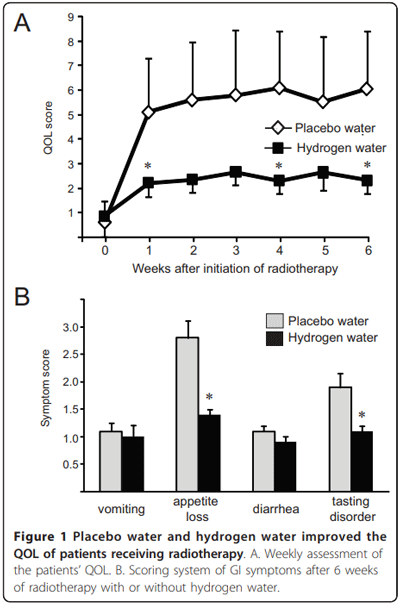
Source: Medical Gas Research
Additionally, the placebo group had elevated levels of hydroperoxide, a marker of inflammation, following radiation therapy. Those who drank hydrogen water did not. Similarly, normal antioxidant activity significantly deteriorated during radiotherapy in the placebo patients but not in the hydrogen-rich water patients, even after six weeks of radiotherapy.
“Hydrogen-rich electrolyzed warm water represses wrinkle formation against UVA ray together with type-I collagen production and oxidative-stress diminishment in fibroblasts and cell-injury prevention in keratinocytes.” Journal of Photochemistry and Photobiology B, 2012. As the title implies, this small study showed that six Japanese subjects who took daily baths in hydrogen-rich water suppressed wrinkle formation. Four experienced improvements in skin quality. In Japan, where hydrogen therapy is widely accepted and practiced, spas often offer hydrogen baths.
“Pilot study: effects of drinking hydrogen-rich water on muscle fatigue caused by acute exercise in elite athletes.” Medical Gas Research, 2012. In this small pilot study, researchers enrolled 10 male soccer players and divided them into a hydrogen water group and a placebo group. The subjects did 30 minutes of cycle ergometer at 75% maximal oxygen followed by 100 repetitions of maximal isokinetic knee extension.
Those who drank the hydrogen water experienced no elevation of blood lactate during heavy exercise. The peak torque of the placebo group significantly decreased during maximal isokinetic knee extension while it did not decrease in the hydrogen group.
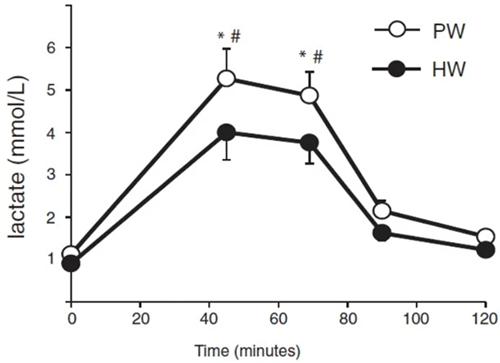
Source: Medical Gas Research
“Removal Effect of Hydrogen Water Drinking on Exercise-Induced Production of Reactive Oxygen Species in Adult Men and Women.” Exercise Science, 2018. This trial also tested the effects of hydrogen on exercise, though at a lesser intensity than the previous study, and found benefits for athletic performance.
Eight healthy subjects aged 45–55, male and female, ran on a treadmill at 8 km/hr for 30 minutes. Blood samples were tested for malondialdehyde (MDA) and 8-oxodG, markers of fatigue and oxidative stress. In the hydrogen group, levels were significantly lower than those in the placebo group. The effect of HW was more pronounced in females than in males.
“Consumption of water containing a high concentration of molecular hydrogen reduces oxidative stress and disease activity in patients with rheumatoid arthritis: an open-label pilot study.” Medical Gas Research, 2012. Though this small trial was not blinded, meaning that participants knew they were drinking hydrogen water, markers of inflammation typical of people with rheumatoid arthritis were very significantly reduced. Four of the five participants had no symptoms of RA at the end of the study.
Twenty patients with RA drank 530 mL of hydrogen water containing 4 to 5 ppm molecular hydrogen every day for four weeks. They then refrained for another four weeks before taking the hydrogen water for another four weeks. Urinary 8-hydroxydeoxyguanosine (8-OHdG) and C-reactive protein (CRP) levels, markers of inflammation, were tested at the end of each four-week period. Meaningfully, both continued to decrease during the four weeks when patients did not drink hydrogen water. During the second drinking period, the mean CRP was reduced. Urinary 8-OHdG was not further reduced but remained below the baseline value.
A 2021 clinical trial with 108 patients with severe COPD included an H2 plus oxygen and an oxygen-only control group. They found superior improvement of symptoms in the group given H2. (See “Hydrogen/oxygen therapy for the treatment of an acute exacerbation of chronic obstructive pulmonary disease: results of a multicenter, randomized, double-blind, parallel-group controlled trial.” Respiratory Research, 2021.)
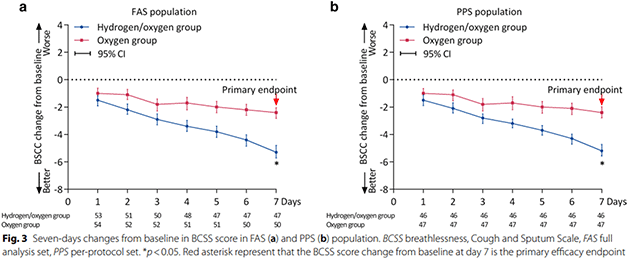
Source: Respiratory Access (Click to enlarge)
“Hydrogen therapy can be used to control tumor progression and alleviate the adverse events of medications in patients with advanced non-small cell lung cancer.” Medical Gas Research, 2020. In this study, 58 patients with advanced non-small cell lung cancer were divided into dosed and control groups. H2 therapy administered by inhalation for four to five hours per day for five months relieved pulmonary symptoms compared to a control group that was also given either chemotherapy, targeted therapy, or immunotherapy. After 16 months, the progression-free survival was higher for the group that was given hydrogen treatment in combination with other therapies than the control group, which received combination treatment without hydrogen. Adverse events from cancer medications were also significantly lower in the H2 group.
This article is probably already too long so I’m going to refer you to a great 2021 review article, “The Medical Uses of Hydrogen.” The authors start with hydrogen therapy animal trials, showing successful treatment of multiple diseases. This includes strokes, cognitive disorders and dementia, Parkinson’s disease, spinal cord injury, heart attacks, arteriosclerosis, liver disease, kidney diseases, lung diseases, intestinal diseases, pancreatic disease, and eye disease. H2 animal studies have shown efficacy in treating generalized inflammation, sepsis, metabolic syndrome, and diabetes. Hydrogen therapy has even been shown to extend lifespans in short-lived animals, including mice.
Also, see “Effects of Molecular Hydrogen in the Pathophysiology and Management of Cardiovascular and Metabolic Diseases.” Reviews in Cardiovascular Medicine, 2024 and “Hydrogen Water: Extra Healthy or a Hoax?—A Systematic Review.” International Journal of Molecular Sciences, 2024.
There is one more article out of Japan that appears to shed important light on hydrogen’s mechanism of action, i.e., how it works. This is where flatulence comes into the picture.
It is somewhat puzzling that hydrogen gas has such powerful effects on biology, despite being exceedingly rare in nature. H2 is only a trace element in the atmosphere, making up about 0.000055% by volume. So we might think there isn’t enough available for our bodies to depend on it.
Recently, however, scientists have noticed that healthy humans and other mammals make their own H2. To be accurate, it is the bacteria in our microbiomes that manufacture hydrogen gas. See “The overlooked benefits of hydrogen-producing bacteria.” Medical Gas Research, 2023.
Because it’s so important, I’ll quote an entire paragraph about the “Super-beneficial bacteria” that produce hydrogen gas:
A hydroxyl radical is an extremely toxic and highly reactive oxygen species that is constantly generated in the mitochondria from birth until death. Since hydrogen is the smallest diatomic molecule, it can easily permeate mitochondrial membranes to react with these hydroxyl radicals and prevent cells from oxidative stress without any side effects. Hydrogen has clinical benefits in many diseases, including neurological diseases, cardiovascular diseases, respiratory diseases, diabetes, liver and metabolic syndrome. More than 1000 papers have been published on the medical applications of hydrogen, including over 90 reports of human clinical trials. These papers confirm that hydrogen is highly effective in the treatment of a variety of diseases and that there are no safety issues. Hydrogen molecules are the only species within the human body that can directly eliminate hydroxyl radicals inside mitochondria. Thus, the effects of hydrogen-producing bacteria outperform other beneficial bacteria, such as lactic acid bacteria and bifidobacteria, that cannot produce hydrogen. Nonetheless, hydrogen-producing bacteria have been neglected by modern medicine, even though they have these remarkable health benefits as “Super-beneficial bacteria.”
The average person’s microbiome produces an estimated eight to 10 liters of H2 daily. As pointed out above, hydrogen diffuses through the entire body eliminating hydroxyl radicals. I’m convinced, in fact, that this is one of the most important functions of our microbial symbiotes.
Studies have shown that eliminating hydrogen-producing bacteria in animals leads to neurological diseases. This is also the case when animals are not given foods that feed H2-producing bacteria.
In the previously cited “The Medical Uses of Hydrogen,” the authors discuss the beneficial effects of α-glucosidase inhibitors on cardiovascular effects. One of these drugs is acarbose, a diabetes drug that has better anti-aging effects than metformin in some populations.
The well-known major side effect of acarbose and other drugs of its class is gas, aka flatulence. Experiments by Suzuki et al., 2009, led these researchers to strongly believe that the benefits of acarbose come from the increase in hydrogen gas produced in the gut.
It is clearly true that our microflora produces hydrogen gas that permeates our entire bodies, crossing the blood-brain barrier and reaching the tiniest organelles in our cells. This raises questions regarding why supplemental hydrogen of the sort used in the clinical trials cited above has such obvious beneficial impacts.
Obviously, supplemental hydrogen will temporarily increase H2 above levels supplied by the microbiome, but that doesn’t explain the long-term impacts of hydrogen therapy. The increasingly popular theory is that the hydrogen pulse from supplementation activates the NRF2 gene complex, which is an extremely important system of genes that regulate anti-inflammatory processes including autophagy, detoxification, mitochondrial function, and cell survival. There are many journal articles that support this theory, but I’ll include just one here: “Molecular hydrogen may activate the transcription factor Nrf2 to alleviate oxidative stress through the hydrogen-targeted porphyrin.” Aging Pathobiology and Therapeutics, 2023.
So, despite having focused on hydroxyl radicals, the impact on the NRF2 gene complex may be more important. Specifically, it seems that the value of supplemental hydrogen may have more to do with the fall in hydrogen levels following administration. This is supported by experiments that show that rodents benefit from short-term daily exposure to hydrogen gas but not permanently elevated hydrogen. The NRF2 gene complex appears to sense this reduction in H2 and adjusts other systems to compensate.
Hydrogen therapy has become popular among the alternative medicine crowd, but its reputation has suffered as a result. One impact of that popularity is that there are scores of products on the market that purport to supply supplemental H2.
There are three basic types. One type produces breathable hydrogen gas. Another produces hydrogen-rich water that you drink. The last are effervescent pills that utilize magnesium and a catalyst to release hydrogen into water.
Frankly, I started out looking for a gas or water device, but I gave up because the quality of these machines is so inconsistent. Testing has shown that some popular devices produce almost no hydrogen while others often fail. All must be resupplied with replacement components on a regular basis. The exceptions are the devices developed for medical clinics in Japan. They, however, cost thousands of dollars apiece and must be regularly serviced.
This leaves effervescent hydrogen pills that consist of magnesium and a catalyst. Most people are magnesium deficient, so these pills offer a double benefit. I’m not telling you, however, to use the ones that I use because I’m not a doctor, and I’d probably put myself at legal risk if I did.
Hydrogen therapy has no known side effects, but there is always a possibility that some new information will come forth that makes me regret having suggested it. On the other hand, one six-month study in humans showed a 4% increase in the length of telomeres, which would theoretically extend your maximum lifespan. The results need to be replicated, but if they are confirmed, it will be a very big deal. (See “The effects of 6-month hydrogen-rich water intake on molecular and phenotypic biomarkers of aging in older adults aged 70 years and over: A randomized controlled pilot trial.” Experimental Gerontology, 2021.)
That said, I use Dr. Mercola brand Molecular Hydrogen almost as soon as I wake up every day. I drop the pill into about 1.5 liters of water and breathe the escaping hydrogen until it is dissolved. Then I drink the hydrogen-rich water immediately, usually without pausing even to breathe. This provides a dose roughly equivalent to those used in most of the clinical trials cited above. I buy mine from Amazon and pay 0.41 cents per day.
John here. I hope you now understand why I wanted you to have this important research, and why I think you should join us at Transformative Age. You can get all the details by clicking here.